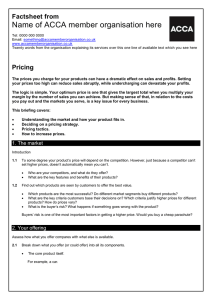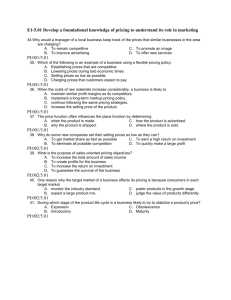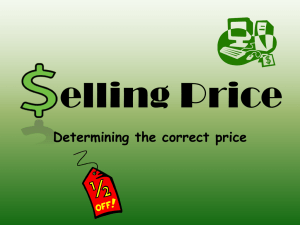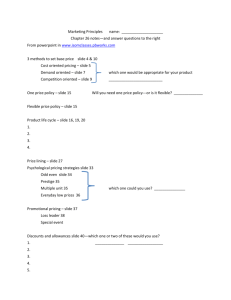Pricing Your offering
advertisement
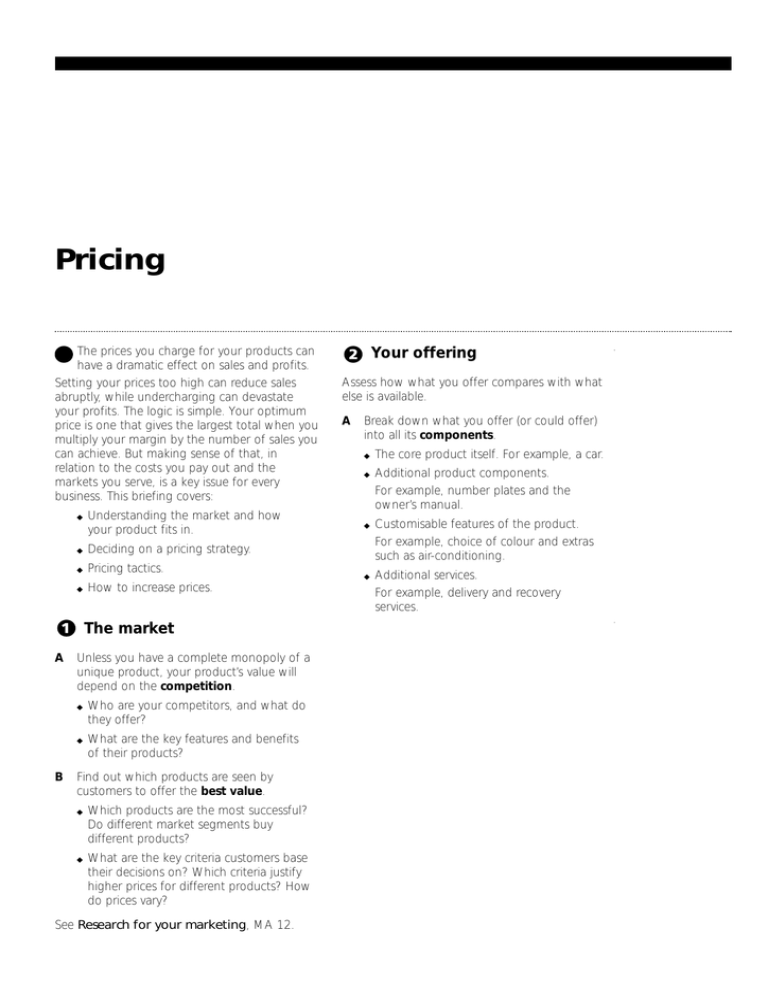
Pricing The prices you charge for your products can have a dramatic effect on sales and profits. Setting your prices too high can reduce sales abruptly, while undercharging can devastate your profits. The logic is simple. Your optimum price is one that gives the largest total when you multiply your margin by the number of sales you can achieve. But making sense of that, in relation to the costs you pay out and the markets you serve, is a key issue for every business. This briefing covers: ◆ Understanding the market and how your product fits in. ◆ Deciding on a pricing strategy. ◆ Pricing tactics. ◆ How to increase prices. The market A Unless you have a complete monopoly of a unique product, your product’s value will depend on the competition. B ◆ Who are your competitors, and what do they offer? ◆ What are the key features and benefits of their products? Find out which products are seen by customers to offer the best value. ◆ Which products are the most successful? Do different market segments buy different products? ◆ What are the key criteria customers base their decisions on? Which criteria justify higher prices for different products? How do prices vary? See Research for your marketing, MA 12. Your offering Assess how what you offer compares with what else is available. A Break down what you offer (or could offer) into all its components. ◆ The core product itself. For example, a car. ◆ Additional product components. For example, number plates and the owner’s manual. ◆ Customisable features of the product. For example, choice of colour and extras such as air-conditioning. ◆ Additional services. For example, delivery and recovery services. ◆ Additional elements of the overall deal. For example, a financing package and guaranteed buy-back price. Include all the components which customers may sometimes ask for — such as rush delivery. B C List all the benefits that customers perceive each component as offering. For example: ◆ Quality and reliability. ◆ Convenience. Assess how much each benefit is worth to your target customers, using what you know about the market (see 1), and additional market research if necessary. servicing, as well as the purchase price. ◆ Many businesses value what they offer intuitively, rather than using this kind of logical process. Pricing strategy A Take account of the constraints on your business. For example: Different benefits will often have different values for different market segments. For example: ◆ ◆ Reliability will be more important to a customer who uses your product in a mission critical application. B A product will be worth more to a customer who can make a large profit from distributing or processing it. Different customer perceptions of value may mean that you should offer different packages to different market segments, or use special pricing tactics (see 5). D Customers’ perceptions of value for money will depend on what they expect their total costs to be. ◆ Investor requirements (eg high short-term returns or long-term growth) and other external influences. ◆ Your financial resources and your production capacity. ◆ Your cost structure (see 4). The most appropriate strategy will depend on how you want to position the product. ◆ In many markets, a high price contributes to the perception of a product as being of premium value. ◆ You may want to establish consistent pricing across your product range, or to position individual products ‘up’ or ‘down’ market. ◆ Different strategies may be appropriate at different stages in the product’s life cycle. For example, capitalising on existing customers’ inertia at the end of a product’s life by charging a high price. For example, the costs of car ownership include depreciation, fuel costs and Aim high Underpricing your product can be even more dangerous than overcharging. A It is far easier to reduce prices than to increase them. ◆ B C C You can charge higher prices if high barriers to entry will prevent the emergence of new competition. For example, if you have a patent, special skills or strong customer loyalty. ◆ Customers will be more loyal if purchasing an unsatisfactory alternative carries significant risk to them. ◆ If barriers are low, you may want to limit your prices (and achieve a merely acceptable return on capital employed) in order to avoid encouraging new entrants. If in doubt, try higher prices first. Customers may not respond to low prices. ◆ A low price may create an image of a low quality product and service. ◆ Your target market may not be particularly price-sensitive. Low prices may attract unprofitable customers. ◆ While prices are low, so are margins. ◆ Price-sensitive customers tend to be disloyal when prices increase. D Cheap products may cannibalise sales of more expensive ones. Providing lifetime value for money is more important if you aim to get repeat business from the same customer. D You may want to charge different prices for different customers. ◆ Customers who purchase repeatedly, or buy add-on or related products, are the most valuable. ◆ Customers who are expensive to satisfy (eg demanding special features or service) will be less profitable, unless you can charge them higher prices. page 2 ◆ the more important it will be to generate high sales volumes. One-off sales generally carry far higher costs than repeat business. ◆ Your costs A A cost-plus approach to pricing has many disadvantages. B It does not take into account the level of demand and competition. ◆ The price you need to charge depends on the volume you sell, which in turn will depend on the price you charge. ◆ In the absence of other reasons, margins below industry norms suggest your costs are too high or your prices too low. ◆ The mistake to avoid is failing to include all your costs in your analysis. If you do this, you will end up undercharging. ◆ Industry margins provide a rough guide to the prices which may be achievable when considering new products. ◆ Cost-plus pricing reduces the pressure to control costs. ◆ Differences in costs can be a useful way of creating consistent pricing across a range of products or markets. ◆ Analysing the additional costs can help to prevent you from undercharging for special orders or demanding customers. Although your costs do not tell you what your prices should be, they do tell you whether they are viable. ◆ If you charge less than your direct variable costs, you will make a loss. ◆ If you charge more than your direct costs, each sale will make a contribution towards covering your fixed costs and ultimately making a profit. The contribution each sale makes towards covering your fixed costs tells you what volume you need to sell to reach breakeven. ◆ If you have high costs relative to your competitors, you will need to position your product with a premium price. ◆ The higher the proportion of fixed costs, A Spell out everything which is included in the price. Tactics A Varying your prices with differential pricing can increase your profitability. For example: B ◆ Charging lower prices for high profile products to capture customers who will also buy higher margin products. ◆ Charging different prices at different times of the day, week or year to reflect changing demand or the changing value to customers of your product. ◆ Charging different prices for different levels of service or product specification. Discounting can be worthwhile, but only if it achieves your aims. ◆ In some industries, trade discounts are the norm and you may have to offer them to match the competition. ◆ For one-off sales, you can compete with an attractive price on the core component of what you are offering. A cash payment discount can encourage early payment. Some customers may claim the discount but delay payment anyway. ◆ Then charge a full price for all the extras once the customer has decided to buy. Clearance discounts can help you to sell off old stock and release working capital. ◆ Bulk discounts encourage large orders, which may carry lower unit costs for you. ◆ Retrospective discounts or rebates may encourage customers to concentrate their purchases with you. ◆ ◆ C See Benchmarking, ST 4. Your cost structure may influence your strategy. Price quotes B D Analysing your costs can be a useful benchmarking exercise. ◆ ◆ C Some costs are unrecoverable if sales are not made soon enough. For example, the costs of underemployed staff, perishable goods and products which become obsolete. Assigning a price to every component (eg delivery) and then giving it back as a discount highlights the value of your offer. Anticipate any negotiation when pricing your product. ◆ Non-negotiable prices can enhance your image of quality and value. page 3 ◆ C Introductory discounts may encourage customers to try a new product. However, they may create the wrong image for your product or generate sales which are not repeated when the discount is removed. They can also cause resentment among current customers. tactics you use. Special tactics may work in particular situations. For example: ◆ ◆ ◆ Bundling additional products together and charging a package price. This works well if the perceived increase in value is greater than the additional costs. B What is the competition doing? ◆ How are customers’ perceptions of the value of your product and competing products changing? Turnover and changes in turnover may indicate a pricing problem or opportunity. ◆ Products with high or growing market share may present an opportunity to increase prices. ◆ If you pitch or tender for business, too high a success rate suggests that you are underpricing. ◆ C If both margins and market share are low, you need to change something — or discontinue the product. Limited trials of price changes can provide valuable information at reduced risk. For example: ◆ Changing the price for a sub-sector of your market. ◆ Introducing a new product at the new price while continuing to offer the old product. Are there signs of unwanted side effects? For example, reduced sales of full price products. ◆ What is the overall effect on profits? ◆ Give customers advance warning if they need to budget for your price increase. ◆ What will the effect on sales volumes be? ◆ What will the effect on margins be? Increasing prices (and hence margins) can sharply increase your profits, even if your turnover drops. B Review your prices regularly to ensure that they are optimal. ◆ ◆ A Analyse the impact on profits of any proposed price change before you make it. Checking your prices A Keep up to date with the market. Are you achieving your aims? For example, increasing sales to target market segments or smoothing capacity usage. Increasing prices Charging a psychologically attractive price. For example, £7.99 can be perceived as being more than a penny less than £8.00. Charging a fixed price across a range of products. This makes it easier for you to predict your income. Also, some customers may prefer being able to compare products without having to make price comparisons. ◆ C Explain to your customers why you are increasing prices. ◆ Use the price change as an opportunity to re-emphasise the benefits you offer. ◆ A good explanation can strengthen your customer relationship. You can try to hide price increases. For example: ◆ By gradually introducing new, higher priced products and making old products obsolete. ◆ By lowering the specification (and your costs), while maintaining the same price. ◆ By improving the specification and raising the price. It is wise to increase the price by more than the cost of the improvement. Hiding price increases runs the risk of adverse reactions when customers realise what you are doing. D A good relationship with customers can help to improve their perception of the value of your product and the risk of trying alternatives. ◆ Spending more on marketing and customer care may allow you to increase margins and turnover. See Building customer loyalty, MA 4. D Analyse the effectiveness of any pricing page 4
